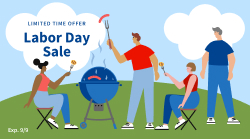AARP Hearing Center
One year of the coronavirus pandemic has dramatically altered how Americans live, learn, work, worship and play.
Delores and John Miles, married 71-year-old retirees who live in McKinney, Texas, opted for grocery delivery, didn't socialize with friends, canceled a European river cruise and stopped going to church, the gym and restaurants.
"At the very beginning, I was optimistic that this was going to be a short-time epidemic that was going to be quickly resolved,” Delores says. “Our whole thought process changed in a matter of months. I feel like our age group was the most threatened. We stopped doing all of the fun things that made our lives mentally healthy."
Her spirits are up since she and John received their second COVID-19 vaccinations in late February and since the CDC issued new guidance that says some socializing is now safe. “We're still wearing a mask and social distancing, but we aren't afraid anymore to step out the door,” Delores says.
Jamais Cascio, a distinguished fellow at the Institute for the Future in California's Silicon Valley calls the past year a “social experiment in radical change” in people's lives.
"There are some things that work and some things that don't, and we learn a lot from it,” he says. “As the impact of the pandemic fades, there's been discussions about how much of the new we will keep."
Many people think some changes are here to stay. Just over half of U.S. adults expect their lives to be transformed in major ways post-pandemic, according to a Pew Research Center survey.
Here's a snapshot of some lifestyle changes from the start of the pandemic to today:
THEN | NOW |
The race to develop a vaccine | Scoring a vaccine appointment |
Pandemic pet adoptions | Busy dog parks |
Dressing up for the heck of it | |
Video chatting with grandchildren | |
Buzz cuts, bobs and highlights | |
Avoiding your doctor | |
Empty buses and trains | |
Lines at ATMs and bank drive-throughs | Venmo |
Igloo dining | |
Live performances go dark | Free concerts and performances online |
Wondering if we need to go back to the office |
Sheryl Jean is a contributing writer who covers aging, business, technology, travel, health and human-interest stories. A former reporter for several daily metropolitan newspapers, her work also has appeared in the Chicago Tribune and The Dallas Morning News and on the American Heart Association’s website.





































































